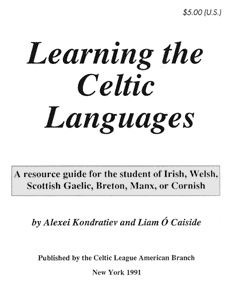

Celtic Languages are just one part of the Celtic heritage — Visual arts, music, dance, and perhaps a certain spirit or approach to life are also parts of Celtic culture. However, the languages are the defining element — the glue that holds the various aspects of the cultural matrix together and makes it “Celtic” as opposed to “English” or to “Irish” or “Scottish” or “Cornish” in a purely geographical sense — and they cannot be separated from the other elements without breaking that cultural mold.
When a group of people, such as the Celts, abandon their language and are assimilated into a larger group with a different language and culture, the material aspects of their original culture which survive typically become provincialisms of the expanding imperial culture. As the people look more and more to the imperial culture for guidance, their old traditions — no longer seen in their original context — fade into obscurity, perhaps to be despised as "old-fashioned," or preserved to be brought out each summer for tourists flocking to fairs and festivals.
Of course, much can be done through the medium of the imperial language to stimulate interest in the Celtic tradition (this web site, for example). But without the native languages, the reaffirmation of Celtic culture will not be complete. If the Celtic languages are allowed to die out, "Celtic" will become a nebulous term, meaning whatever anyone wants it to mean. (The misuse of the term is already too widespread.)
It is in this spirit that the Celtic League American Branch published the Celtic Language Guide in 1991. Written by Alexei Kondratiev and Liam Ó Caiside, the Guide gives you an introduction to all six Celtic languages and some information (some of it outdated, but we hope to update it soon), on where to pursue your interest further.
For an excerpt of the Guide, click here.
To purchase the Guide, click here.